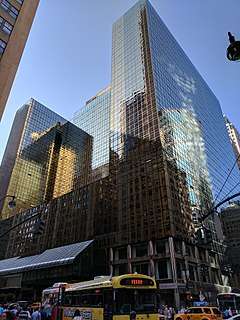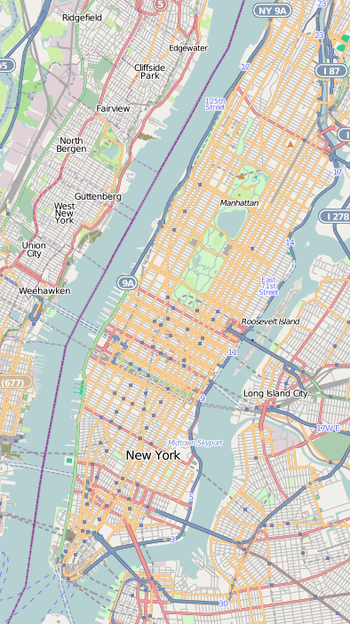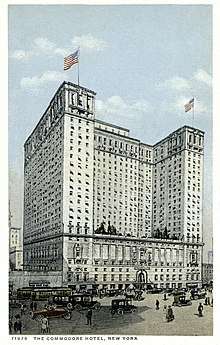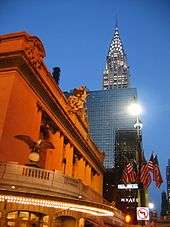Grand Hyatt New York
| Grand Hyatt New York | |
|---|---|
 42nd Street facade of Grand Hyatt New York | |
 Location within Manhattan  Grand Hyatt New York (New York)  Grand Hyatt New York (the US) | |
| Hotel chain | Hyatt Hotels |
| General information | |
| Location | Manhattan, New York |
| Address | 109 East 42nd Street |
| Coordinates | 40°45′07″N 73°58′35″W / 40.752039°N 73.97638°WCoordinates: 40°45′07″N 73°58′35″W / 40.752039°N 73.97638°W |
| Opening | January 28, 1919 original, September 25, 1980 reconstruction |
| Owner | Hyatt |
| Management | Hyatt |
| Height | 295 ft (90 m) |
| Technical details | |
| Floor count | 26 |
| Design and construction | |
| Architect | 1919 – Warren & Wetmore 1980 – Gruzen Samton |
| Other information | |
| Number of rooms | 1306 |
| Website | |
| https://newyork.grand.hyatt.com/ | |
The Grand Hyatt New York is a hotel located directly east of the Grand Central Terminal in Midtown Manhattan, New York City. Originally named The Commodore Hotel, it opened on January 28, 1919. In 1980, Donald Trump modernized the outside of the building and renovated the inside as part of his first construction project in Manhattan.
Commodore Hotel
The Commodore Hotel was constructed by the Bowman-Biltmore Hotels group. The structure itself was developed as part of Terminal City, a complex of palatial hotels and offices connected to Grand Central Terminal and all owned by the New York State Realty and Terminal Company (NYSRTC), a division of the New York Central Railroad (NYCRR). The Commodore was named after "Commodore" Cornelius Vanderbilt, the founder of NYCRR; a statue of Vanderbilt is located outside the hotel. The Commodore was designed by Warren & Wetmore and leased by the NYSRTC to the Bowman-Biltmore Hotels Corporation, of which John McEntee Bowman was president.[1]

The Commodore opened on January 28, 1919. Herbert R. Stone, of NYSRTC, oversaw the decor of its 2,000 rooms. The lobby, called the "Most Beautiful Lobby in The World," was the single largest room in the hotel, with modern low ceilings and a waterfall designed by John B. Smeraldi. A group of conventioneers once told Bowman that "New York City was like a circus," so the next day Bowman, ever a showman, arranged to place a circus, complete with elephants, in the grand ballroom. Another popular spot was the Century Room, which boasted its own orchestra. The Commodore shared a parking garage with its sister hotel, the New York Biltmore Hotel, which had been Bowman-Biltmore's first hotel investment.[1] Another Terminal City property – The Roosevelt Hotel, originally a United Hotel asset – merged with Bowman-Biltmore Corporation on March 4, 1929, giving Terminal City access to all railroad passenger traffic in and out of New York City. One notable person to have stayed at The Commodore was Albert Einstein, who stayed at the hotel for a few weeks in April 1921 during his tour of the east coast of the US promoting the creation of Hebrew University in Jerusalem.
The Commodore was successful for decades, and in June 1967, NYCRR – which by then was running the hotel through a division called Realty Hotels – upgraded the Commodore with a 3.4 million-dollar refurbishment. On May 10, 1972, while John R. Garside was the hotel's general manager, the Commodore became the first hotel in New York City to show in-room movies through Player Cinema Systems. By the late 1970s, both the railroad line (now called Penn Central) and the hotel had become less successful. On May 11, 1977, the now-bankrupt railroad's asset manager, Victor Palmieri, told the city that the Commodore had lost $1.5 million in 1976 and might have to be shuttered.
At that point, Donald Trump reached an option agreement with Penn Central to purchase the Commodore.[2][3] Trump, however, did not have the $250,000 necessary to secure the option.[2][4] Nevertheless, Trump's father, Fred Trump, had a long time political connection through the Brooklyn Democratic machine to then-Mayor Abraham Beame.[4] Despite the city being in the midst of the worst fiscal crisis in its history, Beame's deputy mayor, Stanley Friedman, pushed through a 40-year, $400 million tax abatement on the property.[4] Asked by city officials to supply a copy of the agreement with Penn Central, Trump sent the option agreement paperwork minus the signatures.[2] The abatement moved forward as if the agreement had been signed and as if Trump had paid to secure the option.[2] Trump was then able to convince the Hyatt hotel chain to partner with the Trump Organization and purchase the Commodore.[2]
Grand Hyatt New York
The Trump Organization rebuilt the hotel at a cost of $100 million, gutting the first few floors of the interior down to their steel frame (although the same basic layout of public rooms was retained) and placing a new reflective glass facade on top of the existing masonry exterior. The work was done by the firm of Gruzen Samton,[5] with architect Der Scutt, who would later design Trump Tower, serving as design consultant.[6] The only portion of the hotel's decor left untouched was the foyer to the grand ballroom, with its neoclassical columns and plasterwork. The hotel re-opened on September 25, 1980,[7] as the Grand Hyatt New York, with Governor of New York Hugh Carey and Mayor of New York City Ed Koch in attendance. The new facade was criticized as out of place and as having destroyed the character of East 42nd Street. The American Institute of Architects’ guide to New York buildings referred to the facade as an “utter and inexcusable outrage.”[3]

In 1989, New York State officials ordered the hotel to pay New York City $2.9 million in rent that had been withheld by the hotel in 1986 due to "unusual" accounting changes approved by Donald Trump.[8] An investigation by New York City auditors noted that the hotel was missing basic financial records and found that the hotel was using procedures that violated Generally Accepted Accounting Principles.
The Trump/Hyatt partnership eventually collapsed, with Trump filing a civil racketeering suit against Hyatt owner Jay Pritzker on July 28, 1993, alleging that Hyatt had used improper accounting practices, in order to force Trump out of the partnership with Hyatt, which restricted the chain from operating any other convention hotel in New York City.[9] The Pritzkers countersued on March 28, 1994, alleging that Trump had violated their partnership by failing to remain solvent, using his share in the hotel as collateral for bank loans, and refusing to cover his share of the cost of necessary repairs.[10] The much-needed renovation of the hotel finally began on April 8, 1996, and continued through that August.[11] Finally, on October 7, 1996, the Pritzkers bought Trump's half-share in the hotel for $142 million, ending the partnership.[12][13]
The hotel won the 2007 and 2008 Corporate and Incentive Travel magazine "Award of Excellence." It was completely renovated in 2011, at a cost of $130 million, at which point the 1980s modern interiors were removed.[14] The renovation was complicated by the structure's 1919 origins, including 138 different guest-room configurations.
References
- 1 2 "The World's Newest and Largest Hotels: The Hotel Pennsylvania and The Hotel Commodore". Architectural Review. VIII (3): 55. March 1919 – via Google Books.
- 1 2 3 4 5 Rosenthal, Max J. (July 11, 2016). "The Trump Files: How Donald Tricked New York Into Giving Him His First Huge Deal". Mother Jones. Retrieved 2018-05-08.
- 1 2 Traub, James (December 21, 2000). "Golden Boy". The New York Review of Books. Retrieved 2018-05-08.
- 1 2 3 Rich, Frank (April 29, 2018). "The Original Donald Trump". New York. Retrieved 2018-05-08.
- ↑ Trump, Donald (1987). The Art of the Deal. Warner Books. ISBN 978-0394555287.
- ↑ Bernstein, Fred A. (March 16, 2010). "Der Scutt, Modernist Architect, Dies at 75". The New York Times. Retrieved 2018-04-22.
- ↑ "Grand Hyatt Hotel Pictures". Getty Images. 1980-09-25. Retrieved 2018-04-22.
- ↑ Kates, Graham (August 8, 2016). "Inside a Donald Trump audit: Missing books and unusual accounting". CBS News. Retrieved 2017-01-12.
- ↑ Henriques, Diana B. (July 29, 1983). "Trump Sues Pritzker As a Feud Goes Public". The New York Times. Retrieved 2018-04-22.
- ↑ Henriques, Diana B. (March 29, 1994). "COMPANY NEWS; Pritzker vs. Trump, and Vice Versa". The New York Times. Retrieved 2018-04-22.
- ↑ "Grand Hyatt announces multi-million dollar renovation". Real Estate Weekly. March 20, 1996. Retrieved July 1, 2018.
- ↑ "The Grand Hyatt Hotel". The Trump Organization. Retrieved November 2, 2016.
- ↑ "Trump Sells Hyatt Share To Pritzkers". The New York Times. October 8, 1996. Retrieved November 2, 2016.
- ↑ Bernstein, Fred A. (January 11, 2011). "Grand Hyatt Makover Sheds the Trump Glitter". The New York Times. Retrieved 2018-04-22.